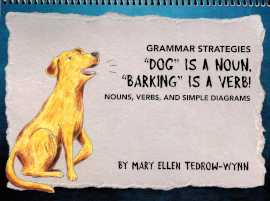The Grammar Strategies series consists of two books with lengthy titles: “Dog” is a Noun, “Barking” is a Verb! Nouns, Verbs, and Simple Diagrams and Over, Under, Above, and Below, Prepositions! Way to Go! They should be used in the order the titles are listed. Both books introduce the parts of speech and sentence diagramming while also providing cursive handwriting practice.
The books are spiral-bound with pages displayed horizontally so that the binding is out of the way for both right- and left-handed writers. The pages are printed in black and white but are “dressed up” with attractive borders.
Each lesson is presented in three parts as Day 1, Day 2, and Day 3—one page per day, although parents should feel free to break lessons up into smaller parts and spread them out over more days.
Students learn through oral lesson presentations by the teacher, memorization, recitation, writing, traditional exercises, and sentence diagramming. Answer keys are found at the back of each book.
Both books assume that children have already learned cursive handwriting, even if they are not yet fluent writers.
“Dog” is a Noun, “Barking” is a Verb! Nouns, Verbs, and Simple Diagrams
Dog is a Noun teaches nouns, verbs, articles, and adjectives at a level appropriate for grades two through five. (Notice that adverbs are not included.) Nouns are taught as common nouns, proper nouns, and collective nouns, and the types of verbs taught are action, state-of-being, and helping.
Parents begin by teaching and reviewing the definitions for the parts of speech as well as the lists of state-of-being verbs and helping verbs found on page 3. These should be reviewed and recited with every lesson. This knowledge is gradually applied in the lessons.
All lessons, except the periodic reviews, follow the same format. At the top of each page, bold print presents the focus of the day’s lesson. For example, Lesson 1, Day 1 is headed, “Dog is a noun, barks is a verb.” A parent reads this and uses the line immediately below it to explain that dog and cat are common nouns, barks is an action verb, and the is an article. An exercise with six short sentences has students underline subject nouns once and verbs twice. This first lesson reveals the occasional gap in the instructions, as in this instance, there has been no mention of subject nouns. Nouns are used only as subjects in this book, and parents might want to clarify this for students.
Next students are shown a sample sentence diagram of the first exercise sentence, “The dog barks.” Then, they are provided with the diagram lines to fill in the words from the fourth sentence. Diagramming remains simple throughout the book, using only subject nouns and verbs with slanted lines under the subject nouns for articles and adjectives.
Below this, they will trace the cursive sentence “The dog barks,” labeling SN and V above the noun and verb and then underlining both. Finally, they write their own sentence, labeling and underlining in the same way.
Over, Under, Above, and Below, Prepositions! Way to Go!
Being able to identify prepositions and prepositional phrases makes understanding the rest of a sentence’s structure much easier, so Over, Under focuses on prepositions. It is appropriate for grades three through five. The lesson format changes for each section.
The first section, which runs through Lesson 6, Day 3, helps students learn the commonly used prepositions by memorization and recitation and by having them circle the prepositions on charts with 28 words. For each day’s chart, they are provided with a list of ten prepositions to find. Below the chart, they will trace and then write several prepositions.
Part 2, Lessons 7 through 17, teach prepositional phrases as students learn that prepositions are at the beginning and are followed by an object of the preposition and might contain articles and adjectives. Students now have to identify prepositions within phrases. They circle the prepositions and label all words within each of five prepositional phrases. Below the phrases, they have a complete sentence to trace. They can copy it again below that or write a sentence of their own. They have the option of labeling the parts of the sentence they know, and it is up to parents or students whether they do so.
Part 3 has students diagram prepositional phrases. Students are given four sentences with the parts of speech identified with abbreviations. To the right of each sentence is the sentence diagram with all except the prepositional phrase filled in up through Lesson 22. (The first of the four sentences on each page also fills in the diagram of the prepositional phrase as a model.) Beginning with Lesson 23, the first diagram is filled in, but the other three diagrams are completely blank. Students can diagram only the prepositional phrases, but they are welcome to fill in the other parts of the sentences. Note that direct objects are included in some of the diagrams, so students trying to diagram complete sentences will need an explanation of how direct objects function in sentences and on diagrams. The sentence structures are consistent and simple. The prepositional phrases are all adverbial although that distinction isn’t made at this point.
Summary
The Grammar Strategies books are easy to use and offer a low-stress way to begin to learn parts of speech and sentence diagramming.









